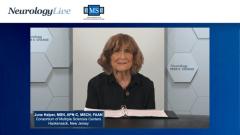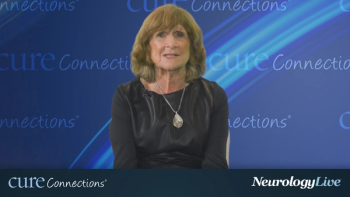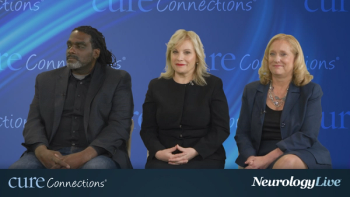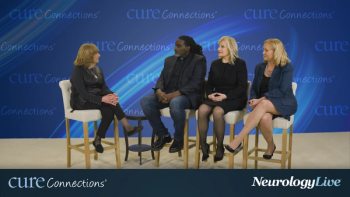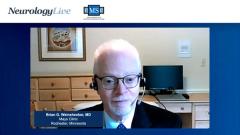
NMOSD Research Programs
Jacinta M. Behne, MA, of the Guthy-Jackson Charitable Foundation, reacts to the types of research programs the organization has been involved in, regarding better treatments for patients with neuromyelitis optica spectrum disorders.
Episodes in this series

June Halper, MSN, APN-C, MSCN, FAAN: Jacinta, you must be satisfied. Has the foundation supported any of the research for any of these three medications or any related research in terms of what you’ve seen the evolution become?
Jacinta M. Behne, MA: We have funded a tremendous body of research, which has resulted in a body of high-impact papers in leading journals. Why? Because we knew that the research had to happen to best help our patient community. When I say we’re a research foundation, we’re really a patient-centric foundation learning that we had to help these patients when there were no therapeutics on the shelf.
To answer your question, we started many years ago in working with pharma. We invited a number of pharma organizations to what we called a partners meeting. They showed up at the Hilton [Los Angeles Airport] talking about this little-known disease of NMO [neuromyelitis optica] and why they should be interested. We needed to have clinical trials in this disease for there to be therapeutic. We knew that they all have drugs that can be repurposed on the shelf and that didn’t meet their mark on other clinical trials. Because we have a known biomarker, we made the argument that NMO could be a steppingstone to learning more about MS [multiple sclerosis] and other autoimmune diseases. Fortunately, at that time, we began working with the FDA. We knew that they were going to want to support clinical trials. The research investment has been buried. The CIRCLES study started in 2013 and came to a close in 2020. That was 7 years of patient data collection and blood specimen collection of 850 patients with NMO. We’re embarking on a new study called SPHERES. We went from CIRCLES to SPHERES; it sounds like we’re circular.
The thing about SPHERES is that we’re working with an organization called CorEvitas. It’s a registry that is accustomed to working with regulatory studies. The end of the trials that have just happened and the therapeutics that just went on the shelf need to pass another phase from the FDA of scrutiny. How safe are they? That’s what SPHERES is all about. We’re reaching out to clinicians and patients. You may be asked by your clinician, “Are you interested in joining the SPHERES study?” I wanted to help you understand why we went from CIRCLES to SPHERES. We did form an industry council because we knew that along the road, we need to have a good collaboration with them for therapeutics.
There are additional industry members who are filing for continued studies in NMO. Scientific research is important, but we also invest in quality of life for patients. We started that study with an organization called Ipsos [Public Affairs] many years ago, and we continue to spend time in surveys for patient-reported outcomes. The answer to NMO is in our patients. They’re going to help us solve this disease. Even with therapeutics on the shelf, there’s much to learn. There’s something called the relapse navigator tool. Once you have an initial event, the questions on the patient’s mind is, “Will I relapse? When will I relapse? Have I relapsed?” Neurologists tell us patients come in all the time. “I have these signs. Could they be a relapse?” We’ve been at work with Dr [Brian] Weinshenker and with Dr [Dean] Wingerchuk with something called the relapse navigator. Ultimately, we’re still in the validation stage, but when it’s finally rolled out for all, it’s a tool that will help clinicians adjudicate a relapse. It’s a tremendous instrument, and we’re very grateful for our neurologists for helping this along. We’ve gotten heavily involved in many kinds of research because this disease will be solved in many ways.
June Halper, MSN, APN-C, MSCN, FAAN: You guys have made a huge impact on the disease itself, and Dr Weinshenker has shared with me how important your organization is. You’ve got to be very proud with the impact and the changes you’ve seen over the past decade. It’s unusual that you see this kind of change in such a short period of time.
Jacinta M. Behne, MA: Bill and Victoria Jackson, both started by very humble means, worked hard and have become successful in their independent lives and dedicated over $65 million of their personal assets to solve this disease. Victoria always says, “Let’s not pat ourselves in the back yet. Let’s get this work all done first. Let’s make sure our patients are treated and well treated.” They’re tremendous people who have a great love for their daughter. Ally came to her mom 1 day and said, “Mom, it’s not just about you and me anymore, it’s about all of us.” This was about the second year we were in our work. Yes, researchers are important.
June Halper, MSN, APN-C, MSCN, FAAN: Thank you for watching Neurology Live® Cure Connections®. If you enjoyed this program, please subscribe to our e-newsletter to receive upcoming programs and other great content in your in-box.
Transcript edited for clarity.
Newsletter
Keep your finger on the pulse of neurology—subscribe to NeurologyLive for expert interviews, new data, and breakthrough treatment updates.



